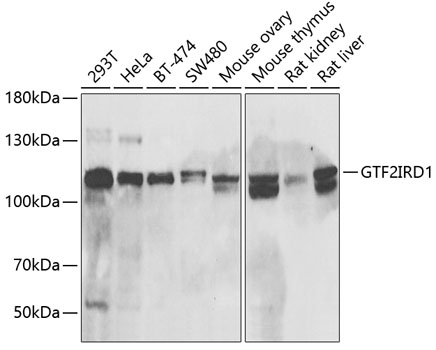Anti-GTF2IRD1 Antibody (CAB6613)
- SKU:
- CAB6613
- Product type:
- Antibody
- Reactivity:
- Human
- Mouse
- Rat
- Host Species:
- Rabbit
- Isotype:
- IgG
- Antibody Type:
- Polyclonal Antibody
- Research Area:
- Epigenetics and Nuclear Signaling
Frequently bought together:
Description
| Antibody Name: | Anti-GTF2IRD1 Antibody |
| Antibody SKU: | CAB6613 |
| Antibody Size: | 20uL, 50uL, 100uL |
| Application: | WB |
| Reactivity: | Human, Mouse, Rat |
| Host Species: | Rabbit |
| Immunogen: | Recombinant fusion protein containing a sequence corresponding to amino acids 660-959 of human GTF2IRD1 (NP_057412.1). |
| Application: | WB |
| Recommended Dilution: | WB 1:500 - 1:2000 |
| Reactivity: | Human, Mouse, Rat |
| Positive Samples: | 293T, HeLa, BT-474, SW480, Mouse ovary, Mouse thymus, Rat kidney, Rat liver |
| Immunogen: | Recombinant fusion protein containing a sequence corresponding to amino acids 660-959 of human GTF2IRD1 (NP_057412.1). |
| Purification Method: | Affinity purification |
| Storage Buffer: | Store at -20°C. Avoid freeze / thaw cycles. Buffer: PBS with 0.02% sodium azide, 50% glycerol, pH7.3. |
| Isotype: | IgG |
| Sequence: | SLGF SPPA LPPE RDSG DPLV DESL KRQG FQEN YDAR LSRI DIAN TLRE QVQD LFNK KYGE ALGI KYPV QVPY KRIK SNPG SVII EGLP PGIP FRKP CTFG SQNL ERIL AVAD KIKF TVTR PFQG LIPK PDED DANR LGEK VILR EQVK ELFN EKYG EALG LNRP VLVP YKLI RDSP DAVE VTGL PDDI PFRN PNTY DIHR LEKI LKAR EHVR MVII NQLQ PFAE ICND AKVP AKDS SIPK RKRK RVSE GNSV SSSS SSSS SSSS NPDS VASA NQIS LVQW PMYM VDYA GLNV QLPG PLNY |
| Gene ID: | 9569 |
| Uniprot: | Q9UHL9 |
| Cellular Location: | Nucleus |
| Calculated MW: | 104kDa/106kDa/107kDa |
| Observed MW: | 106kDa |
| Synonyms: | GTF2IRD1, BEN, CREAM1, GTF3, MUSTRD1, RBAP2, WBS, WBSCR11, WBSCR12 |
| Background: | The protein encoded by this gene contains five GTF2I-like repeats and each repeat possesses a potential helix-loop-helix (HLH) motif. It may have the ability to interact with other HLH-proteins and function as a transcription factor or as a positive transcriptional regulator under the control of Retinoblastoma protein. This gene plays a role in craniofacial and cognitive development and mutations have been associated with Williams-Beuren syndrome, a multisystem developmental disorder caused by deletion of multiple genes at 7q11.23. Alternative splicing results in multiple transcript variants. |
| UniProt Protein Function: | GTF2IRD1: May be a transcription regulator involved in cell-cycle progression and skeletal muscle differentiation. May repress GTF2I transcriptional functions, by preventing its nuclear residency, or by inhibiting its transcriptional activation. May contribute to slow-twitch fiber type specificity during myogenesis and in regenerating muscles. Binds troponin I slow-muscle fiber enhancer (USE B1). Binds specifically and with high affinity to the EFG sequences derived from the early enhancer of HOXC8. GTF2IRD1 is located in the Williams-Beuren syndrome (WBS) critical region. WBS results from a hemizygous deletion of several genes on chromosome 7q11.23, thought to arise as a consequence of unequal crossing over between highly homologous low-copy repeat sequences flanking the deleted region. Haploinsufficiency of GTF2IRD1 may be the cause of certain cardiovascular and musculo-skeletal abnormalities observed in the disease. Belongs to the TFII-I family. 3 isoforms of the human protein are produced by alternative splicing. |
| UniProt Protein Details: | Protein type:DNA-binding Chromosomal Location of Human Ortholog: 7q11.23 Cellular Component: cytoplasm; nucleoplasm; nucleus Molecular Function:DNA binding; RNA polymerase II transcription factor activity, enhancer binding; transcription factor activity Biological Process: multicellular organismal development; regulation of transcription from RNA polymerase II promoter; regulation of transcription, DNA-dependent; transcription, DNA-dependent; transition between slow and fast fiber Disease: Williams-beuren Syndrome |
| NCBI Summary: | The protein encoded by this gene contains five GTF2I-like repeats and each repeat possesses a potential helix-loop-helix (HLH) motif. It may have the ability to interact with other HLH-proteins and function as a transcription factor or as a positive transcriptional regulator under the control of Retinoblastoma protein. This gene plays a role in craniofacial and cognitive development and mutations have been associated with Williams-Beuren syndrome, a multisystem developmental disorder caused by deletion of multiple genes at 7q11.23. Alternative splicing results in multiple transcript variants. [provided by RefSeq, Nov 2010] |
| UniProt Code: | Q9UHL9 |
| NCBI GenInfo Identifier: | 21263630 |
| NCBI Gene ID: | 9569 |
| NCBI Accession: | Q9UHL9.1 |
| UniProt Secondary Accession: | Q9UHL9,O95444, Q6DSU6, Q75MX7, Q86UM3, Q8WVC4, Q9UHK8 Q9UI91, |
| UniProt Related Accession: | Q9UHL9 |
| Molecular Weight: | 107,979 Da |
| NCBI Full Name: | General transcription factor II-I repeat domain-containing protein 1 |
| NCBI Synonym Full Names: | GTF2I repeat domain containing 1 |
| NCBI Official Symbol: | GTF2IRD1 |
| NCBI Official Synonym Symbols: | BEN; WBS; GTF3; RBAP2; CREAM1; MUSTRD1; WBSCR11; WBSCR12; hMusTRD1alpha1 |
| NCBI Protein Information: | general transcription factor II-I repeat domain-containing protein 1 |
| UniProt Protein Name: | General transcription factor II-I repeat domain-containing protein 1 |
| UniProt Synonym Protein Names: | General transcription factor III; MusTRD1/BEN; Muscle TFII-I repeat domain-containing protein 1; Slow-muscle-fiber enhancer-binding protein; USE B1-binding protein; Williams-Beuren syndrome chromosomal region 11 protein; Williams-Beuren syndrome chromosomal region 12 protein |
| Protein Family: | General transcription factor II-I repeat domain-containing protein |
| UniProt Gene Name: | GTF2IRD1 |
| UniProt Entry Name: | GT2D1_HUMAN |






